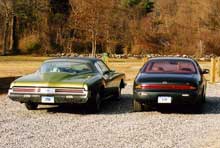What could these two cars possibly have in common? They were built 20 years apart, on different continents by different companies. One has a massive 455 cubic inch American V8, the other a 24-valve 3-liter Japanese V6. Other than the fact that they’re both front-engine- rear-drive, about the only thing they share is their designer, Jerry Hirshberg.
Born in Cleveland, Ohio, Hirshberg earned a degree in industrial design from Cleveland Institute of Art, and joined General Motors in 1964. In his early years he worked on such cars as the first-generation Pontiac Firebirds, the Grand Prix and the GTO. By the late 1960s he had moved up to head the advanced design studio, where he was given the task of satisfying design vp Bill Mitchell’s request for a car with “classic lines.” Hirshberg and his studio reached back to the yacht-inspired themes championed by E.T. Gregorie in the 1930s, cars like the Lincoln-Zephyr and Continental, and came up with the “boat tail” Buick Riviera, introduced in 1971. Actually, the Riv went the Continental one better, being pointed both front and rear.
In 1980, Hirshberg was scouted by Nissan, then establishing a design studio in the United States. He was tapped to head the new Nissan Design International (now Nissan Design America), then being built in San Diego, California. Among the first jobs at NDI were Nissan’s Hardbody trucks, including the first Pathfinder. An innovative concept was the Pulsar NX, a modular two-seater that could function as a T-top coupe, Targa-style roadster or small “Sportbak” wagon.
It was shortly after the NX that Hirshberg was given the task of designing a mid-level car for Infiniti, Nissan’s Lexus-fighting luxury brand. The J30, new for 1993, was nearly as distinctive as the boat-tail Riv, but in different ways. For inspiration, his team at NDI took not the shape of a boat but that of a toilet bowl – the underside of the toilet bowl (I’m not making this up; you can read it in Hirshberg’s book, page 120).
The J30 presented special challenges, since Hirshberg’s bosses were Japanese and had different concepts of beauty. He had to revise the front air intake (J30s don’t really have a “grille”) to make it less like a frown, and make the headlights less “squinty.”
One thing the Riv and the J30 have in common is being unappreciated in their own time. Neither sold well, and the Riv disappointed even its designers. For manufacturing reasons it was enlarged from its original A-body concept to ride GM’s B-body platform; Mitchell said that in the process his “speedboat became a tugboat.” It lasted but three years. The J30 survived for almost five, by which time it had been nudged out by the I30, basically a redecorated Nissan Maxima with leather. The J30’s lines, in subdued form, were perpetuated in the first coming of the Nissan Altima.
The 1973 Riviera atop this page belongs to my friend Al Washburn, who likes the big GM V8s. The J30 was my daily driver for 4-1/2 years, pensioned off only as it approached 250,000 miles. It had two significant flaws, a tiny trunk, a result of the “toilet bowl” rear end, and terrible traction due to a light tail and plenty of power. I did become enamored of the Infiniti label, though, and replaced the J30 with an I30, which has a huge trunk and, with front-wheel drive, plenty of grip for New England winters.

